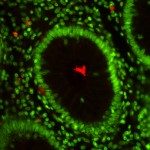Link to Pubmed [PMID] – 3098560
EMBO J. 1986 Nov;5(11):3013-9
The Bacillus subtilis genes encoding threonine synthase (thrC) and homoserine kinase (thrB) have been cloned via complementation of Escherichia coli thr mutants. Determination of their nucleotide sequences indicates that the thrC stop codon overlaps the thrB start codon; this genetic organization suggests that the two genes belong to the same operon, as in E. coli. However, the gene order is thrC-thrB in B. subtilis whereas it is thrB-thrC in the thr operon of E. coli. This inversion of the thrC and thrB genes between E. coli and B. subtilis is indicative of a possible independent construction of the thr operon in these two organisms. In other respects, comparison of the predicted amino acid sequences of the B. subtilis and E. coli threonine synthases with that of Saccharomyces cerevisiae threonine dehydratase and that of E. coli D-serine dehydratase revealed extensive homologies between these pyridoxal phosphate-dependent enzymes. This sequence homology, which correlates with similarities in the catalytic mechanisms of these enzymes, indicates that these proteins, catalyzing different reactions in different metabolic pathways, may have evolved from a common ancestor.

